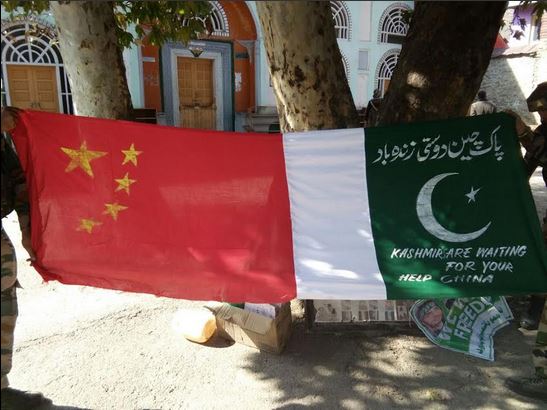Kashmir has a history for setting a new ‘normal’ ever since religious fanatics hijacked the state in the late 80s. Initially, threats and attacks against the Hindu minority symbolized the new normal. Then it was attacks against security agencies. This was followed by a long period of terror strikes against the state and its institutions. Then came the agitators and the teenage stone pelters. Since last year or so, flags of Pakistan and ISIS being waved, especially after Friday prayers is seen as the new normal.
That having been said, the appearance of Chinese flags in Kashmir, along with the usual Pakistani and ISIS flags, at a time when BRICS and BIMSTEC leaders were gathering in Goa took security and intelligence agencies by surprise.
Indian intelligence and security establishment has always been spooked by the possibility of a 2-front war, overt or covert, with Pakistan and China. While the emergence of Chinese flags in Kashmir might be the effort of over-enthusiastic teenagers, it has set alarm bells ringing in India’s security establishment. There is a credible fear that Pakistan and its Iron-brother, China are joining hands in a sinister way to mire India further in Kashmir, to dilute Indian government’s focus on cornering Pakistan.
That China and India are not best of friends is a well-known fact.
What is worse that China has regularly used Pakistan as a counterweight to India in international forums. In fact, China has made extensive use of Pakistan to counter India’s influence in South Asia and the global community. Attempts by India to proscribe Pak-based militants have regularly hit the Chinese wall. China’s opposition to India in NSG, permanent membership of the UN and other forums should be seen in this light. Additionally, China itself is a party to J&K dispute. In addition to occupying Aksai Chin, which it gained from India in 1962 war, China is also in possession of Trans-Karakoram Tract, also known as Shaksgam, which Pakistan transferred to China in 1963, illegally, as Pakistan’s occupation of J&K (of which Shaksgam is a part) is itself highly contested. As if this weren’t enough, China is bogged down by massive investments in Pak-occupied Kashmir and the restive Balochistan region. With India upping the ante on Balochistan, and Pakistan frequently coming very close to imploding, China realizes that it will need to actively tackle the Indian elephant.
The CPEC (China-Pakistan Economic Corridor), has increasingly become the albatross around China’s neck. The corridor passes through some of the world’s most disturbed territories. The Gilgit-Baltistan region of Kashmir, which is populated by Shiites, has seen active anti-Pakistan demonstrations recently. It is believed that region effectively exists as a colony of Pakistan and its citizens are chafing under Pakistan’s rule. Balochistan on the other hand, where China has invested billions to build the Gwadar port and gain access to the Persian Gulf is gripped by an insurgency against the Pakistani state. It is therefore plausible that China will cooperate with Pakistan to foment trouble in Kashmir, to keep extend security to its possessions in Pakistan.
China’s role in 1971 Indo-Pak war was highly favourable to Pakistan. While not opening the second front against India, China sent arms and ammunition to West Pakistan, while at the same time upped the diplomatic ante against India. With PM Modi’s recent I-Day reference to Balochistan, Chinese think tanks are spooked that India is playing a dirty game against Pakistan. An independent Balochistan, or even a Balochistan up in rebellion, would endanger Chinese investments in the region. This is perhaps why, Chinese agencies have gone on the offensive and are closely working with Pakistan to bleed India in Kashmir. A restive Kashmir would dent India’s claims on being the next superpower in making. This would work to China’s advantage as it now sees the end of a long honeymoon period of economic rise. China is already restless at the pace of growing US-India bonhomie and perceives India as a tool in US’s hands to contain China. A weak India works in China’s advantage in two ways. One by containing US’s influence in the region and second by eliminating a potential rival to itself.
However, China seems to be ultimately playing a self-defeating game. Its own West is troubled by the rise of Islamic extremism and separatism. Minority Muslim Uyghurs that inhabit lands bordering Pakistan and Central Asia are repeatedly rising up in revolt against the Chinese government. Uyghur militants are supported by the Al-Qaeda, the ISIS and other Islamic extremist groups. Not so long ago, disturbing reports of attacks and riots in Xinjiang had made headlines in China and the world. By allying with a chief disemminator of international Islamic terrorism, China is playing with fire. There is reason to believe that once the extremists have been freed from Syria, Libya and elsewhere, they will unsettle Xinjiang, just like Afghan terrorists and militants, freed from the Soviet invasion in the 90s, went on to destabilize rest of the world.
For now, Indian agencies seem to have acted promptly against this threat. A massive search in Baramulla recently led to the arrest of 44 terrorists and capture of incriminating material including flags of Pakistan, China and ISIS. India will need to be extremely alert in the coming days to foil the nefarious designs of terrorists and their backers in Pakistan and China. India will also need to tackle China diplomatically and ask it to keep its nose out of Kashmir. Modi will need to use all of his skills to control China as he navigates India through this particularly troublesome period.
References:
http://timesofindia.indiatimes.com/…/articlesh…/54922854.cms
